Vultr VPS For WHMCS
Updating your Vultr VPS For WHMCS module to version 2.0.0?
Make sure to follow the update instruction.
Contents |
About Vultr VPS For WHMCS
| Vultr VPS For WHMCS is a module that allows fully automated management of Vultr VPS servers. The module will allow your clients to remotely control the status of a server, access the console, rebuild the VPS and many others. |
- Admin Area Features:
| ✔ Create/Suspend/Unsuspend/Terminate Server |
| ✔ Change Package |
| ✔ Start/Stop/Reboot Server |
| ✔ Access noVNC Console |
| ✔ View Instance Status And Details |
| ✔ View Assigned Public IPv4 And IPv6 Network Details |
| ✔ Reinstall Server With App Templates: |
| ✔ Applications |
| ✔ ISO Images |
| ✔ Operating Systems |
| ✔ Snapshots |
| ✔ View/Schedule/Restore Automatic Backups |
| ✔ Mount Custom ISO |
| ✔ View/Create Firewall Rules |
| ✔ View Assigned Reserved IP Addresses |
| ✔ View/Create/Manage Reverse DNS Records |
| ✔ View/Create/Restore Snapshots |
| ✔ Provide Cloud-Init User-Data Initiation Script |
| ✔ View Scheduled Tasks |
| ✔ Configure Product Details: |
| ✔ Choose Region |
| ✔ Choose Plan |
| ✔ Provide Default Reverse DNS Template |
| ✔ Toggle DDOS Protection |
| ✔ Toggle Automatic Backups |
| ✔ Toggle IPv6 Address |
| ✔ Use Hostname In Label Field |
| ✔ Enable White Label noVNC Console |
| ✔ Select Default Application Group And Default Application |
| ✔ Choose Features Available In Client Area: |
| ✔ App Template |
| ✔ Backups |
| ✔ Console |
| ✔ Firewall |
| ✔ Graphs |
| ✔ Snapshots |
| ✔ Reverse DNS |
| ✔ Reserved IP Addresses |
| ✔ User Data |
| ✔ Custom ISO |
| ✔ Enable Instance Block Storage With Defined Type And Size |
| ✔ Set Snapshots Limit |
| ✔ Enable Reserved IPv4 And IPv6 Addresses Within Defined Limits |
| ✔ Generate Configurable Options |
| ✔ Run API Connection Test |
- Addon Module Features:
| ✔ Configure App Templates: |
| ✔ Applications |
| ✔ ISO Images |
| ✔ Operating Systems |
| ✔ Snapshots |
| ✔ Create Application Groups And Assign App Templates |
| ✔ Manage Media Library With Logotypes For App Templates |
| ✔ View Queue Of Scheduled Tasks |
| ✔ Customize Module Language Files With "Translations" Tool |
| ✔ View And Manage Logs |
- Client Area Features:
| ✔ Start/Stop/Reboot Server |
| ✔ Access noVNC Console |
| ✔ View Instance Status And Details |
| ✔ View Assigned Public IPv4 And IPv6 Network Details |
| ✔ View Scheduled Tasks |
| ✔ Reinstall Server With App Templates: |
| ✔ Applications |
| ✔ ISO Images |
| ✔ Operating Systems |
| ✔ Snapshots |
| ✔ View/Schedule/Restore Automatic Backups |
| ✔ Mount Custom ISO Images |
| ✔ View/Create Firewall Rules |
| ✔ View Bandwidth Usage Graph |
| ✔ View Assigned Reserved IP Addresses |
| ✔ View/Create/Manage Reverse DNS Records |
| ✔ View/Create/Restore/Delete Snapshots |
| ✔ Provide Cloud-Init User-Data Initiation Script |
- Configurable Options:
| ✔ Application |
| ✔ Backups |
| ✔ Block Storage |
| ✔ Block Storage Size |
| ✔ Block Storage Type |
| ✔ DDOS Protection |
| ✔ IPv6 Support |
| ✔ Reserved IPv4 Addresses |
| ✔ Reserved IPv6 Addresses |
| ✔ Plan |
| ✔ Region |
| ✔ Snapshot Limit |
- Available Images And Applications:
| ✔ Linux OS: |
| ✔ AlmaLinux |
| ✔ Arch Linux |
| ✔ Alpine Linux |
| ✔ CentOS |
| ✔ Debian |
| ✔ Fedora |
| ✔ Fedora CoreOS |
| ✔ Flatcar Container Linux |
| ✔ FreeBSD |
| ✔ OpenBSD |
| ✔ openSUSE |
| ✔ Rocky Linux |
| ✔ Ubuntu |
| ✔ Microsoft Windows: |
| ✔ Windows Core 2022 |
| ✔ Windows Core 2019 |
| ✔ Windows Core 2016 |
| ✔ Windows Server 2022 |
| ✔ Windows Server 2019 |
| ✔ Windows Server 2016 |
| ✔ Windows Server 2012 RS |
| ✔ Marketplace Apps: |
| ✔ 3CX Phone System |
| ✔ 3DKit |
| ✔ aaPanel |
| ✔ AIDungeon2 |
| ✔ Anaconda |
| ✔ Ant Media Server (Community Edition/Enterprise Edition) |
| ✔ Asp.net |
| ✔ AzuraCast |
| ✔ Bitnami via Vultr (Jenkins/Magento/PrestaShop) |
| ✔ BotGuard Ingress Controller |
| ✔ BrowserBox |
| ✔ Bun |
| ✔ Chevereto |
| ✔ Clever VPN Server |
| ✔ CloudHub |
| ✔ CloudPanel 2 |
| ✔ Cloudron |
| ✔ ClusterControl |
| ✔ Colyseus |
| ✔ ComfyUI |
| ✔ Coolify |
| ✔ Coder |
| ✔ cPanel |
| ✔ CyberPanel |
| ✔ Debian 12 with Automatic Updates |
| ✔ Docker |
| ✔ Drupal |
| ✔ Easypanel |
| ✔ Elasticsearch |
| ✔ FASTPANEL |
| ✔ Fauxpilot |
| ✔ FileCloud |
| ✔ Forgejo |
| ✔ GitLab |
| ✔ Grafana |
| ✔ Haltdos |
| ✔ Helpy Pro |
| ✔ InvokeAI |
| ✔ Ispmanager |
| ✔ Jamulus |
| ✔ Jitsi |
| ✔ Joomla |
| ✔ k3s |
| ✔ Keitaro |
| ✔ KobaltAI |
| ✔ LAMP |
| ✔ Laravel |
| ✔ LEMP |
| ✔ LibreChat |
| ✔ Librum Server |
| ✔ LinuxPatch Appliance |
| ✔ Mediawiki |
| ✔ Microweber Website Builder |
| ✔ Minecraft (Bedrock/Forge/PaperSpigot/Vanilla) |
| ✔ Miniconda |
| ✔ Mist Community Edition |
| ✔ MLDev |
| ✔ MongoDB Community Edition |
| ✔ Nextcloud |
| ✔ NirvaShare |
| ✔ NodeJS |
| ✔ ONLYOFFICE (Docs/Workspace) |
| ✔ OpenLiteSpeed (Django/Drupal/Joomla/NodeJS/Rails/WordPress) |
| ✔ OpenVPN Access Server |
| ✔ Palworld |
| ✔ PasswordLab |
| ✔ Plesk (Web Admin SE/Web Host/Web Pro) |
| ✔ PrestaShop |
| ✔ Pritunl |
| ✔ Prometheus |
| ✔ Restyaboard |
| ✔ Roxy-WI |
| ✔ SeaTable |
| ✔ ServerWand |
| ✔ Squidex |
| ✔ Statusnook |
| ✔ Steam |
| ✔ Strapi |
| ✔ Supabase |
| ✔ Talos Linux |
| ✔ Ubuntu Desktop (Gnome/KDE/XFCE) |
| ✔ Uptime |
| ✔ UTunnel VPN |
| ✔ VDev |
| ✔ Video2x |
| ✔ Virtuozzo Multi-cloud App Platform |
| ✔ VitalPBX |
| ✔ Vodia Phone System |
| ✔ Vultr Broadcaster |
| ✔ Vultr GPU Stack |
| ✔ Vultr WebApp |
| ✔ WarpSpeed VPN |
| ✔ Webmin |
| ✔ Wireguard |
| ✔ WooCommerce |
| ✔ WordPress |
| ✔ WP Squared |
| ✔ xrDebug |
| ✔ Yeastar P-Series Phone System |
| ✔ ISO Images: |
| ✔ Finnix |
| ✔ GParted |
| ✔ Hiren's BootCD PE |
| ✔ SystemRescue |
| ✔ Snapshots |
| ✔ Any Other OS Platforms And Solutions When Made Available By Vultr |
- General Info:
| ✔ Fully Integrated With Lagom WHMCS Client Theme |
| ✔ Multi-Language Support With Custom Translations Tool |
| ✔ Supports PHP 8.2 Back To PHP 8.1 |
| ✔ Supports WHMCS Themes "Six" And "Twenty-One" |
| ✔ Supports WHMCS V8.12 Back To WHMCS V8.9 |
| ✔ Requires ionCube Loader V14 Or Later |
| ✔ Easy Module Upgrade To Open Source Version |
Installation and Configuration
| This tutorial will show you how to successfully install and configure Vultr VPS For WHMCS. We will guide you step by step through the whole installation and configuration process. |
Installation
| 1. Log in to our client area and download the module. |

|
| 2. Extract the package and upload its content into the main WHMCS directory.
The content of the package to upload should look like this. |
| 4. When you install Vultr VPS For WHMCS for the first time you have to rename the 'license_RENAME.php' file. The file is located in 'modules/servers/VultrVps/license_RENAME.php'. Rename it from 'license_RENAME.php' to 'license.php'. |

|
| 5. In order to configure your license key, you have to edit the previously renamed 'license.php' file. Enter your license key between quotation marks as presented on the following screen. |

|
| 6. Now, set up the 'storage' folder as recursively writable. This folder is available at '/yourWHMCS/modules/servers/VultrVps/'. |

|
Activating Addon Module
| 7. Now, you have to activate the module in your WHMCS system. Log in to your WHMCS admin area. Go to 'System Settings' → 'Addon Modules'. Afterward, find 'Vultr VPS' and press the 'Activate' button. |

|
| 8. In the next step, you need to grant access to this module. To do so, click on the 'Configure' button, go to the 'Access Control' area, and check the required admin role groups. Press 'Save Changes'. |
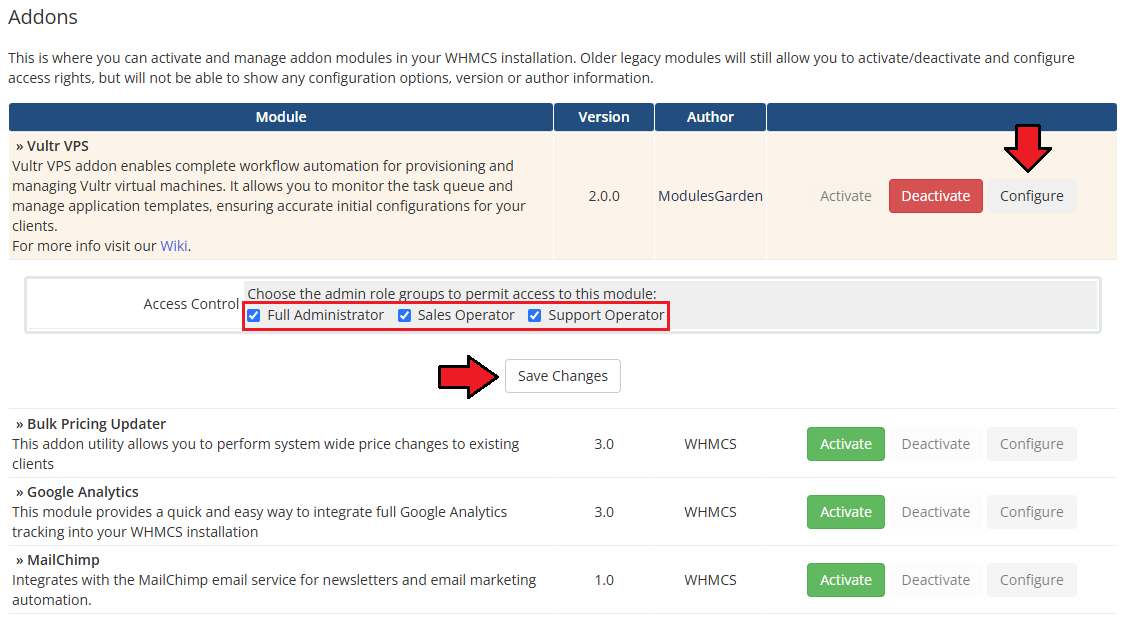
|
| 9. The final step of the module installation is setting up a cron command that is required for several module features to work properly. Note: The cron execution is required for products in version 1.1.0 and later. php -q /yourWHMCS/modules/servers/VultrVps/cron/cron.php queue Remember to replace "yourWHMCS" with a proper directory. |

|
Configuration of Server
| Before you can go on, you must generate your Vultr API Token. You will need it to connect with the server successfully. Underneath you will find instructions on where to find your API details. |
| 10. Firstly, log into your Vultr account at: https://my.vultr.com/. |

|
| 11. Move to the 'API' details section under your account.
There find the 'Personal Access Token' section and generate your API Key. |

|
| 12. Now, log in to your WHMCS and proceed to 'System Settings' → 'Servers' and press 'Add New Server'. |

|
| 13. Next, enter your server name and a hostname or an IP address. Then select 'Vultr VPS' from the 'Type' field. Now, provide the previously generated API token in the 'Password' field. Then check the connection, if successful, save the changes. |

|
| 14. It is time to create a server group. To do so, click on 'Create Server Group'. |
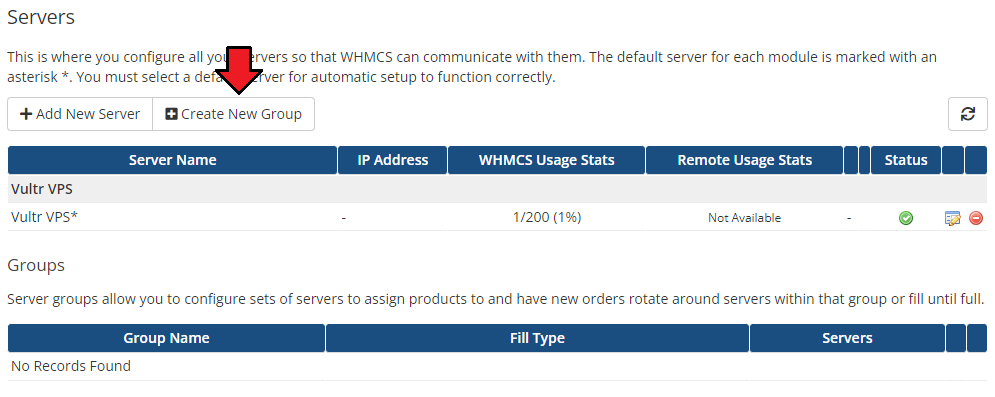
|
| 15. Enter a name, click on your previously created server, press 'Add' and afterward 'Save Changes'. |

|
Configuration of Product
| 16. In order to create and configure a product, go to 'System Settings' → 'Products/Services'. Click on 'Create a New Group' . |

|
| 17. Enter a product group name and press 'Save Changes'. |

|
| 18. When you have a product group, you can create your product. To create a product click on 'Create a New Product' . |

|
| 19. Afterward, choose your product group and type from the dropdown menus, enter your product name and press 'Continue'. 'Product Type' should be set to 'Shared Hosting'. |

|
| 20. Now, go to the 'Module Settings' section, choose both 'Vultr VPS' and your previously created server group from the dropdown menus. The module should automatically save and reload settings. If not, click on 'Save Changes' manually. |

|
21. Proceed to 'Configuration'.
|

|
22. Proceed with 'App Template Configuration'.
|

|
| 23. Next, select features available at the client area. You can also decide which images used to rebuild the server will be available to your customers. |

|
24. Enable additional options and set up configuration per each one of them:
|

|
| 25. At the end of the configuration process, you can decide whether you want to generate configurable options for the product. Configurable options can be used by your clients to select each virtual machine parameter individually during order placement. |

|
| If you decide to use configurable options, press the 'Create' button and select which options you want to generate. We recommend using either |

|
Management
| This guide is divided into three main sections to provide a clear and comprehensive understanding of the module's functionality. The first section, 'Addon', covers the basic configuration and management of the module addon. Each part is designed to give you an easy-to-understand overview of the module's features. |
Addon
| The addon provides administrators with the tools to efficiently monitor and manage the module's functionality, while also offering customization options tailored to client needs. It includes a task 'Queue' for managing pending actions, a 'Logs' section for tracking activity, and 'App Templates' for preparing applications for clients. |
Queue
| In this section, you will find a list of all the tasks issued by the module. You can filter tasks by type with the 'Show More' buttons. |

|
The information on each task includes:
You may also use the action buttons to:
To find specific tasks use the search and sorting functions. |

|
Task details include:
|

|
| Related log entries can be found in a separate tab. |

|
| Tasks can also be deleted with the mass action function. |

|
| Additional actions include the 'Auto Prune' system, which will automatically delete tasks after a predefined number of days and an option to disable cron job information. |

|
The options are in order:
|

|
App Templates
| 'App Templates' allow you to manage and ultimately provide applications, ISO images, operating systems, and snapshots to your clients. Prepare templates in the 'Applications' tab and gather them into groups in the 'Groups' tab. |
Applications
| Read the guide carefully, as it contains crucial information on how to use 'App Templates'. You can change the settings and have the guide collapsed by default. Clicking on the 'Additional Actions' button, select 'Options' and 'Collapse Guide'. |

|
| You can switch between Applications, ISO Images, Operating Systems, and Snapshots by clicking on relevant tabs. |

|
| You can use the refresh button to download and later refresh templates from the server. |

|
| Once the items are loaded, you can use the action buttons to edit, duplicate or delete them from the list. You can also use the mass action buttons to manage multiple templates at once. |

|
Groups
| With the templates ready, all that is left is to gather them into groups and include said groups into products. Navigate to 'App Templates' → 'Groups' and click on the 'Create' button. |

|
Read the information, then provide the group with:
Note: Keep in mind that Vultr includes Windows licenses (Core and Standard) in their Plans and charges a monthly fee for them. |
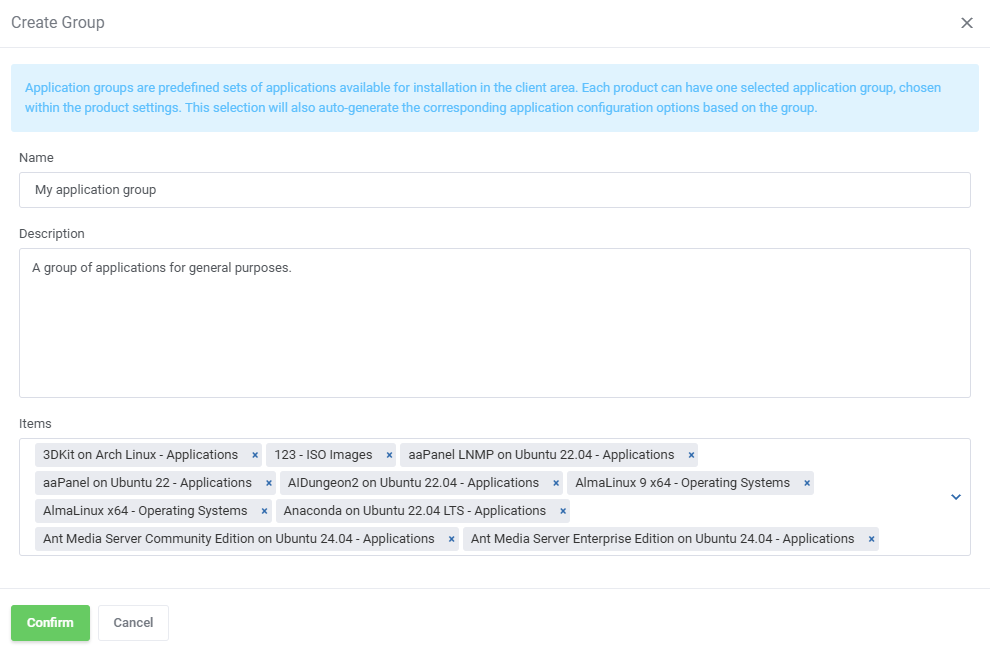
|
| You can use the action button and the mass action function to edit and delete groups. |

|
| For the client to take advantage of the application templates, the product module settings have to include the group. Find the 'App Templates Configuration' section and 'Default Application Group' field. |

|
| Make sure 'App Templates' section is enabled under 'Client Area Features'. |

|
Advanced Configuration
| App templates allow for even more in-depth management with the ability to create and edit custom applications.
See the examples below to learn about the most important options. |
Adding Applications Manually
| Manually add a single application, instead of loading all your applications at once. 1. Navigate to 'App Templates' → 'Applications' and click on 'Create'. |

|
| 2. Download the list of applications from you panel's API.
See the official official Vultr documentation too learn how. curl "https://api.vultr.com/v2/applications" \ -X GET \ -H "Authorization: Bearer ${VULTR_API_KEY}" Example result: {
"applications": [
{
"id": 1,
"name": "LEMP",
"short_name": "lemp",
"deploy_name": "LEMP on CentOS 6 x64",
"type": "one-click",
"vendor": "vultr",
"image_id": ""
}
|
| 3. In the 'Name' field we recommend including the value of the '"name": "$name"' field.
For example 'LEMP' from: "name": "LEMP", Note: If you include a 'name' setting detail (see step 4) with the name from the request as its value, you can safely rename the application to something else here. |

|
| 4. Edit your newly added application, and under 'Settings Details' edit/create application details outputted by the panel's API. |
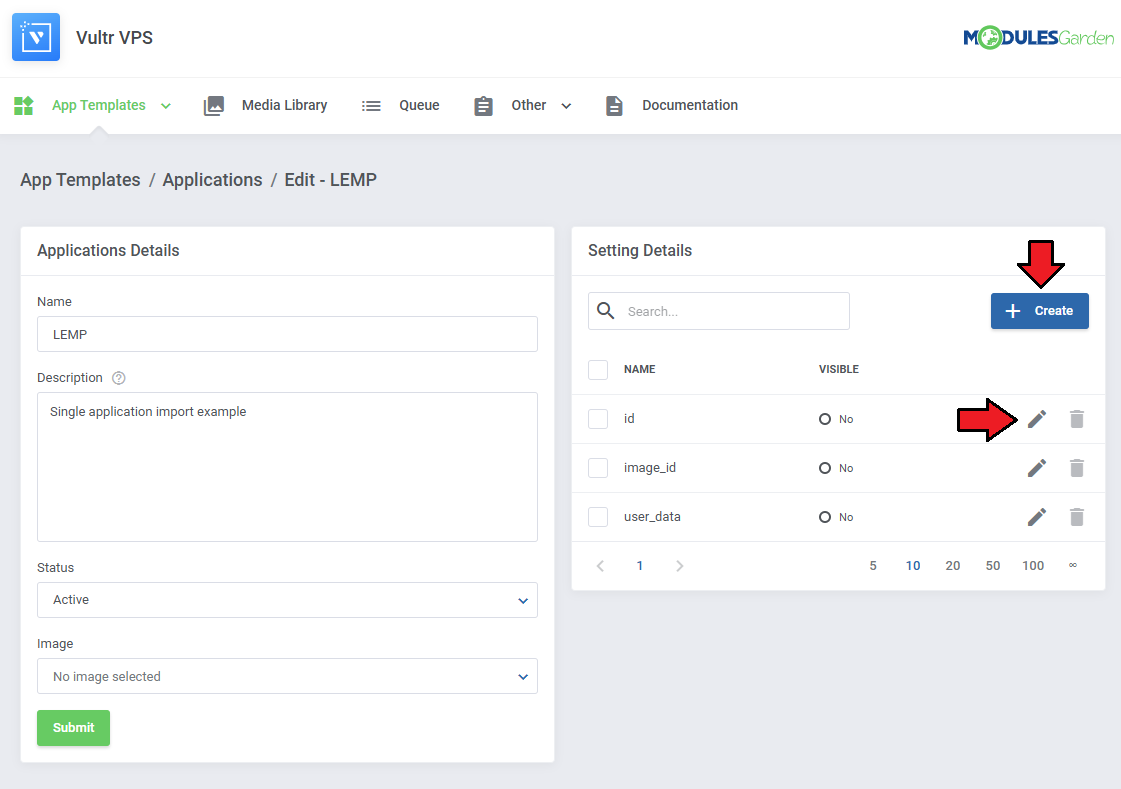
|
| Carefully look at the API output and fill out the 'Name' and 'Default Value' fields with you application details.
In our case it is: "id": 1, |

|
| Add the remaining settings following the same pattern of filling the 'Name' and 'Default Value' fields. |

|
| The application will be available on the list and ready to be included in a group. |

|
Including Cloud-Init / User-Data Scripts
| Enter the user data to run common configuration tasks when the instance starts. You can run cloud-init directives or shell scripts for Linux images. You may use smarty variables, e.g. {$password}. Note: Please refer to the following article to find a list of supported module parameters and their descriptions. If an application supports scripts, the responsible setting will always be added automatically. |
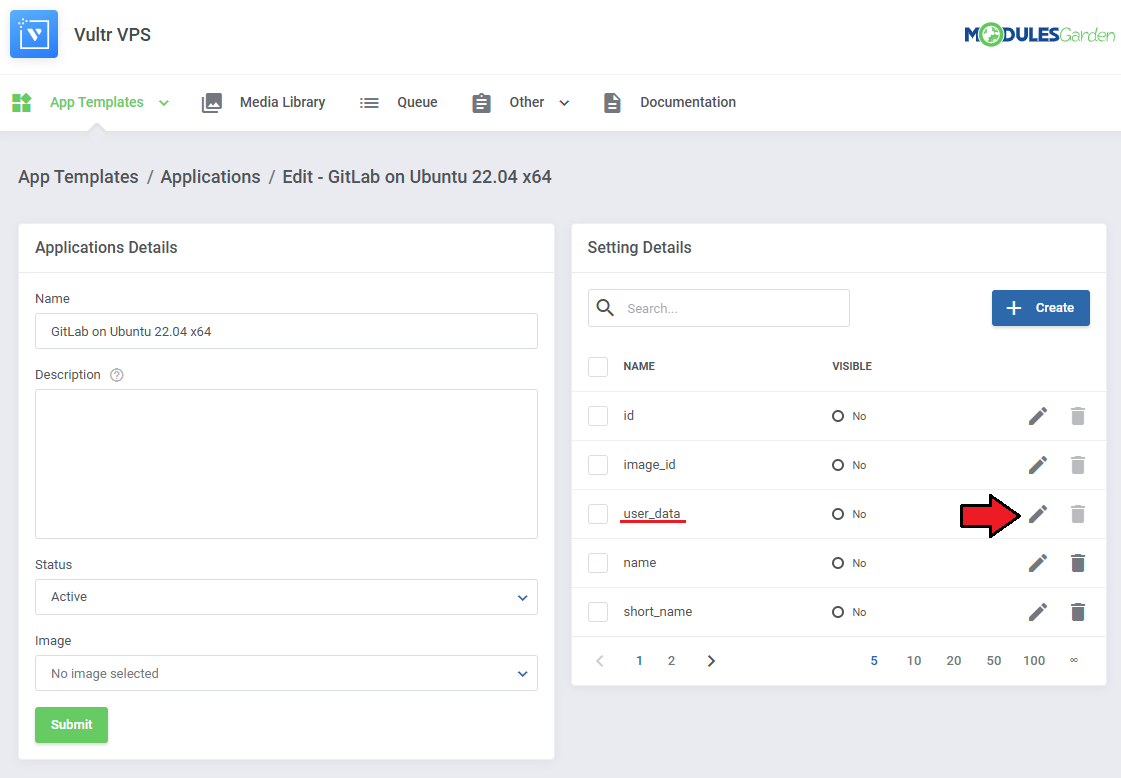
|
See the list below to learn how to set up the setting.
|

|
| If the 'Visibility' toggle is on, the script will be accessible before the installation, if not, the script will just be performed as normal. |

|
Media Library
| The media library allows you to upload images for use elsewhere in the module by admins and clients. To upload a new picture, click on the 'Upload Image' button. |
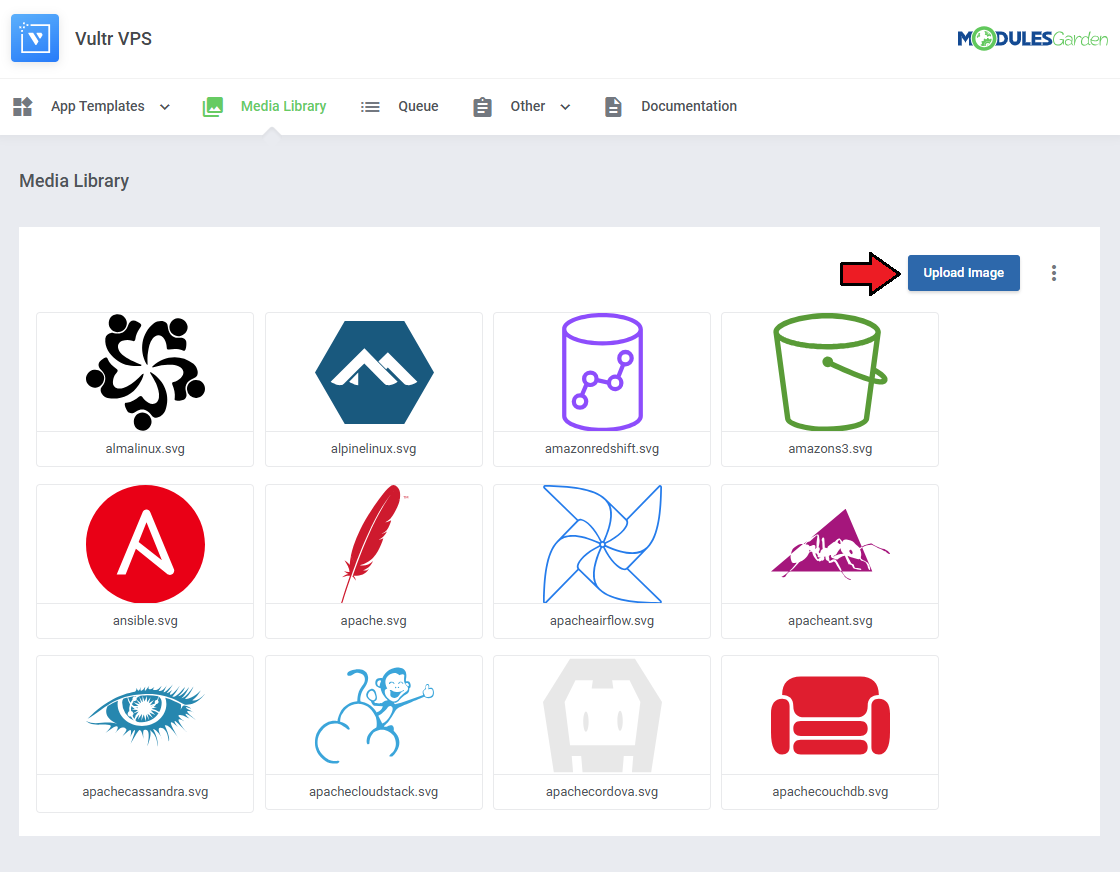
|
| You can delete images one by one by clicking on them. To delete all images at once, use the additional action button. |
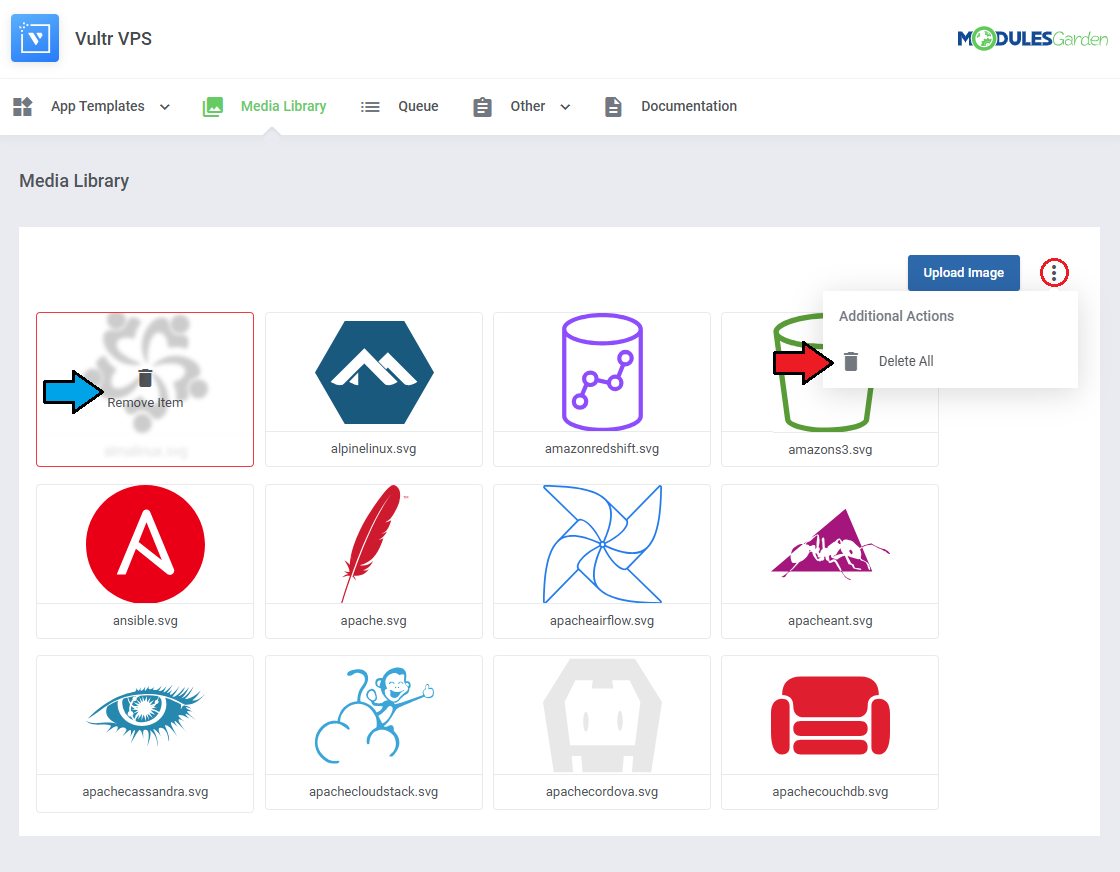
|
Other
Translations
| Customizing language files is now extremely easy with the "Translations" tool that is now available directly in the addon. Its user-friendly design makes managing various language file tweaks a smooth and efficient process. Prepare translations for the original English files with this handy built-in tool. For specific instructions on how to use this tool please refer to its dedicated article, you will find it here. |
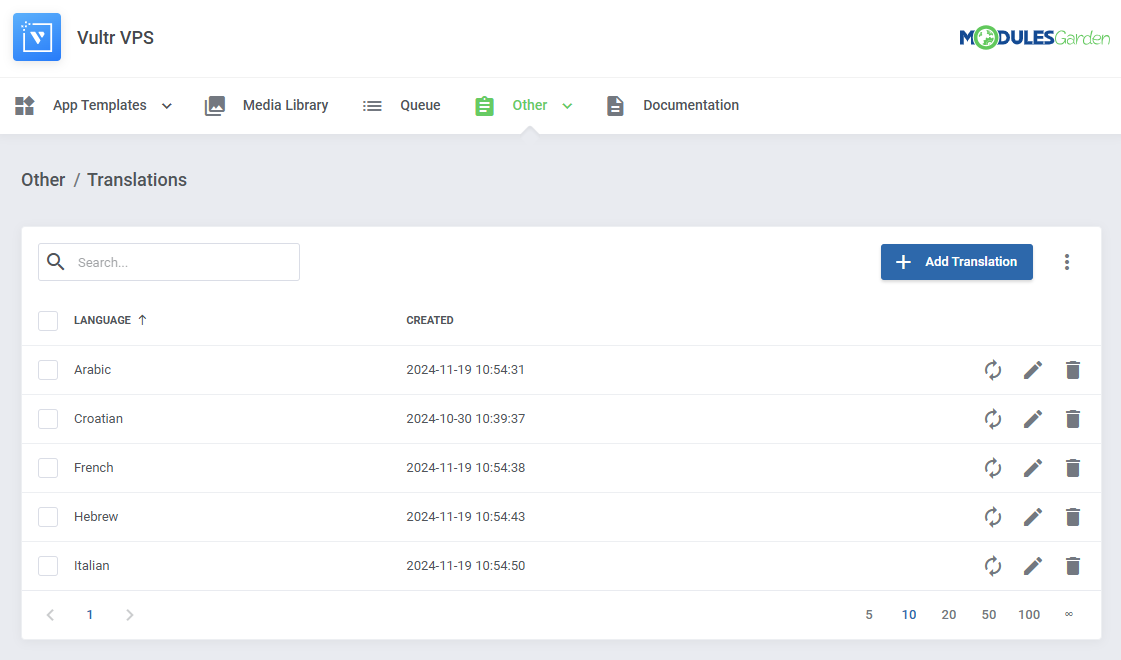
|
Logs
| The 'Logs' section under the 'Other' tab is where the module logs are stored. You can filter the module logs by type with the 'Show' buttons:
|

|
| You can delete logs either one by one or with the mass delete function. |
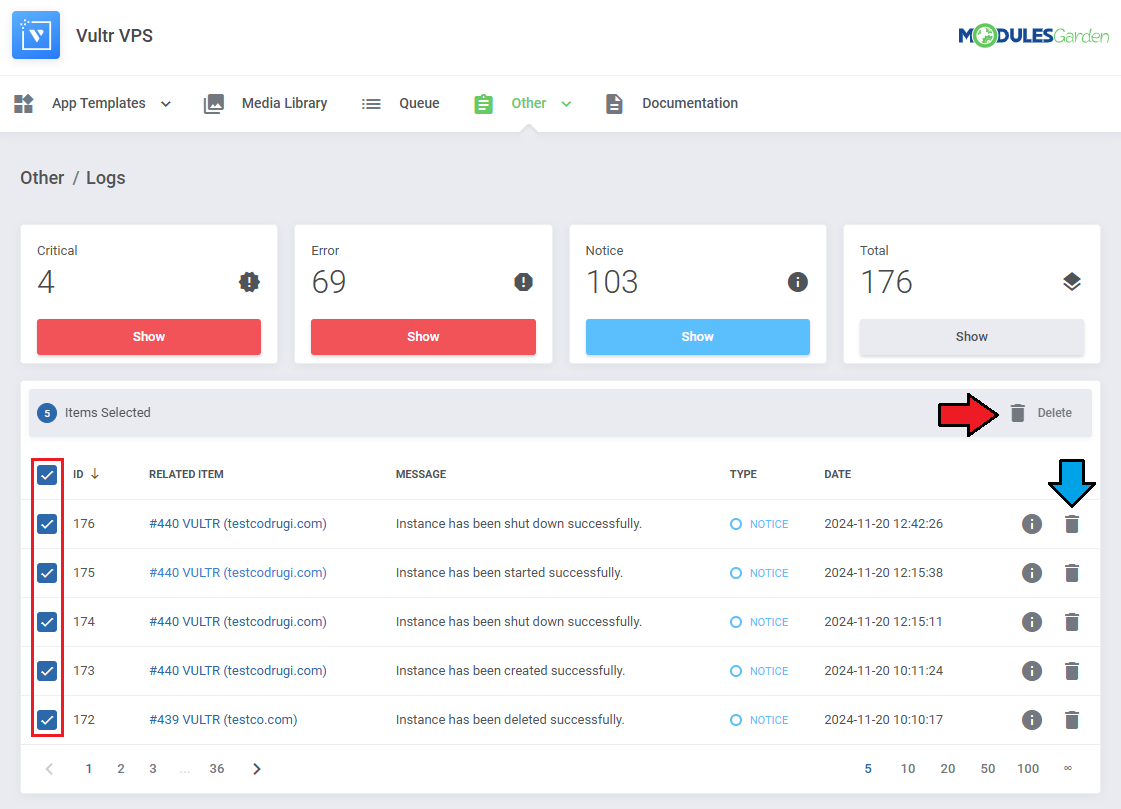
|
Additional actions include:
|

|
In the settings you may decide:
|

|
While exporting you will have to specify which logs to export:
|

|
| You can also delete specific logs without finding them manually. Simply define:
|

|
Admin Area
| Vultr VPS For WHMCS allows your customers to manage their servers via the client area in your WHMCS system. You can monitor and manage each product from your WHMCS admin area.
|

|
Ordering
| Owing to configurable options, you are able to offer a product that your clients can tailor according to their needs. Additionally, you are able to set up pricing for each configurable option, which makes your offer even more competitive. |

|
Importing Existing Instance
| In this section, you can find short instructions on how to connect one of your clients to your already existing instance in the Vultr panel. Take the following steps to make sure that the process will be carried out properly. 1. Firstly, manually create an order for your customer in WHMCS. Choose a client and in the summary, view click on the ' Add New Order' button. Next, select a 'Product/Service' and press 'Submit Order' .
The above-mentioned information has to be consistent with the data from your Vultr panel. Now, complete this field as presented below. |

|
| 3. If the completed data is correct, after refreshing the page, you will see the attached instance from Vultr. Important! Remember to manually add other missing parameters of the instance such as domains, credentials, IP Addresses, configurable options, etc. so they match the parameters of the attached instance from Vultr panel. |
Client Area
| Client area interface of Vultr VPS should look like the one on the screen below. As you can see, the control panel contains useful options needed for managing a virtual machine. The module allows your customers to easily start, stop, and reboot their servers by pressing a specific button. |

|
App Templates
| The 'App Templates' allows you to easily install applications, ISO images, operating systems and snapshots on your VPS. Important: Installations will wipe all existing data from the machine. |

|
Backups
| The first section available for clients grants the ability to view the list of existing 'Backups' of your server. Please remember that 'Backups' are assigned to a particular server and will be removed once the server is deleted. Note: There is a limit of a maximum of two backups per server. Once a new backup is created, the oldest one is automatically removed. |

|
| Clients are also given the opportunity to schedule incoming backups by pressing the 'Schedule Backups' button. Provide a time details to wait until the next backup is created. |

|
| To restore a VPS from backup, simply press the 'Restore' button next to it. If selected backups are no longer needed, you may easily delete them. |

|
Console
| One of the most interesting functionality is a noVNC console where your clients can remotely manage their servers. To access it, simply click on the 'Console' button. Note: Vultr offers a generic VNC URL that serves as a white-label URL. If you wish to use a white-label console with the Vulr VPS For WHMCS module, please contact the Vultr support via their official ticketing system. |

|
Custom ISO
| "Custom ISO" feature allows clients to pick a single ISO and mount it to the machine. Note: Mounting a custom ISO requires rebooting the machine. |

|
Firewall
| The firewall management page allows your customers to view, add, or delete existing rules on a security group assigned to the product. To add a new firewall rule, use the button marked on the following screen. |

|
Next, fill out the rule details to create it:
Press 'Confirm' when ready. |
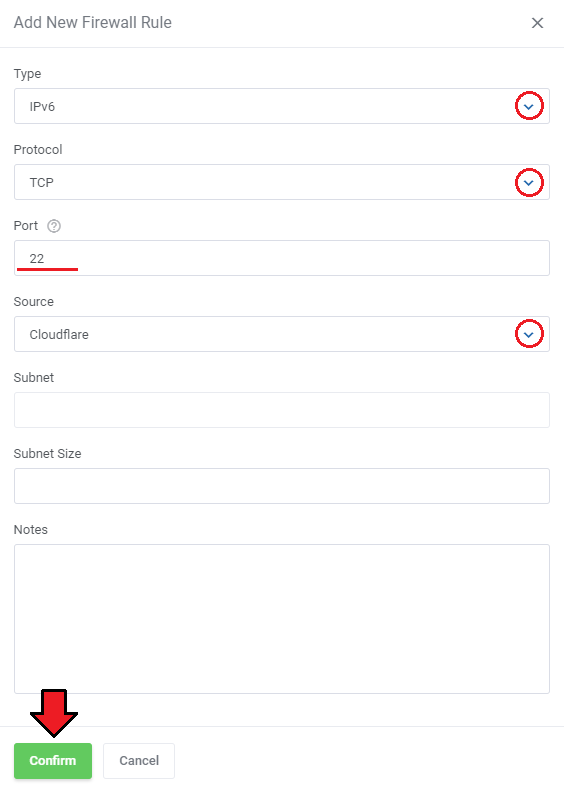
|
Graphs
| Once entering the 'Graphs' section, clients will be moved to the page with the generated graphs showing the 'Bandwidth' usage. |

|
Reserved IP Addresses
This section includes a list of all existing in the panel reserved IP addresses.
|

|
Reverse DNS
| Reverse DNS option allows your clients to manage reverseDNS of the IP addresses assigned to the machine. You can change the hostname that will appear when getting the hostname belonging to the primary IPs (IPv4 and IPv6) of your server. |

|
| When 'IP' and 'Reverse DNS' are provided, just confirm the action. |
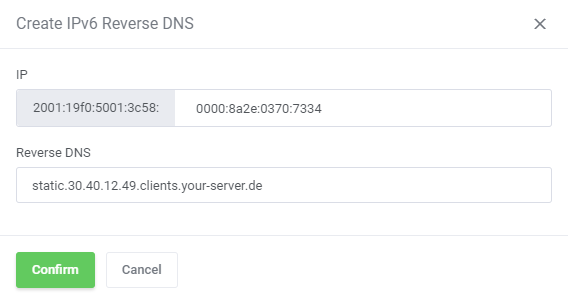
|

|
Snapshots
| Creating snapshots allows customers to quickly restore any changes to a virtual machine in case of any problems. Once the shutter has been created, the customer can restore it (1), change its description (2) or delete it (3). |

|
| After pressing the 'Create Snapshot' button, the new window will pop up along with the possibility to specify the snapshot description. Please note that taking a new snapshot may take a while to process. |

|
User Data
| User data can be freely altered in the client area. Remember that after introducing any changes, the machine restart is required to apply the changes. Note: User data supports smarty variables, such as '{$password}'. Follow to this article to find a full list of supported module parameters and their descriptions. |

|
Tips
| 1. Vultr offers a generic VNC URL that serves as a white-label URL. If you wish to use a white-label console with the Vulr VPS For WHMCS module, please contact the Vultr support team via their official ticketing system. |
| 2. If you may choose among all four configurable options to configure your VPS when placing an order, they will be prioritized in the following manner:
'Operating System' → 'Snapshot' → 'ISO' and 'Application' as the least one on the list. |
Update Instructions
| An essential guidance through the process of updating the module is offered here. Ensure successful completion of the module update by carefully following each step, thereby preventing data loss or any unforeseen issues. |
| While upgrading to version 2.x make sure to follow those guidelines: 1. Make sure all tasks are finished, as the migration process will delete them. php -q /YOUR_WHMCS/modules/servers/VultrVps/cron/cron.php upgrade run 2.0.0 6. Optionally, restore changes made to the language files. |
Upgrade Guide
| Seeking a solution that offers greater flexibility, customization tailored to your precise needs, and unrestricted availability? There is an option that not only proves to be cost-effective in the long run but also includes prioritized support services, making it a truly valuable investment. Opt for the Open Source version of your Vultr VPS For WHMCS module to unlock these benefits. Follow a comprehensive guide covering the transition process, the advantages it brings, and step-by-step instructions on what to do next after the order has been successfully finalized. |
Common Problems
| 1. When you have problems with connection, check whether your SELinux or firewall does not block ports. |
| 2. Downgrading virtual machines with block storage is impossible. Move to the official Vultr documentation to find out more. |
| 3. Due to restrictions of Vultr itself, applications of the 'once-click' type can only be installed on fresh installations (during the 'CreateAccount' action). They can also only be reinstalled into operating systems, but not different applications. |